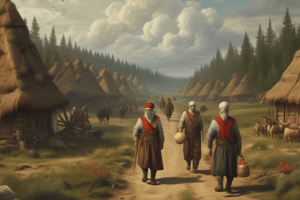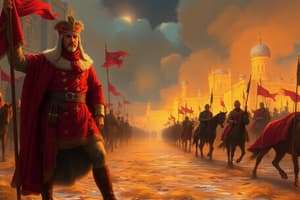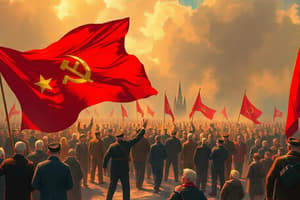Podcast
Questions and Answers
What did Alexander II and Nicholas I share the conviction of?
What did Alexander II and Nicholas I share the conviction of?
That American slavery was inhumane.
What was serfdom not technically?
What was serfdom not technically?
Slavery.
What was based on land?
What was based on land?
Lord and Serf.
When did the Russian system date back to?
When did the Russian system date back to?
What were the nobles to express?
What were the nobles to express?
When did Russia enter the Crimean War?
When did Russia enter the Crimean War?
How many years later did it suffer a heavy defeat?
How many years later did it suffer a heavy defeat?
What was the impact of this on the Russian Empire?
What was the impact of this on the Russian Empire?
Who was unable to save Russia from military failure?
Who was unable to save Russia from military failure?
What was the symbol of Russia's worth?
What was the symbol of Russia's worth?
In which year of his reign was Alexander determined on emancipation?
In which year of his reign was Alexander determined on emancipation?
What did the emancipation show about the power of the Tsar?
What did the emancipation show about the power of the Tsar?
When was the document of emancipation finally presented?
When was the document of emancipation finally presented?
How many separate measures were there?
How many separate measures were there?
What was the basic aim of emancipation?
What was the basic aim of emancipation?
What did the serfs get the leftovers of?
What did the serfs get the leftovers of?
How many thirds did the landowners retain?
How many thirds did the landowners retain?
How many thirds did the peasants receive?
How many thirds did the peasants receive?
What were the peasants reduced to buying?
What were the peasants reduced to buying?
What did this prove difficult to do?
What did this prove difficult to do?
What percentage of mortgages were landowners advanced?
What percentage of mortgages were landowners advanced?
What percentage of these mortgages were provided by the State Bank?
What percentage of these mortgages were provided by the State Bank?
What percentage was by the landlords?
What percentage was by the landlords?
What did the redemption payments become for the peasants?
What did the redemption payments become for the peasants?
The mir would also be controlling?
The mir would also be controlling?
Instead of being tied to the land what was the peasant now tied to?
Instead of being tied to the land what was the peasant now tied to?
Between which years was there 712 peasant uprisings?
Between which years was there 712 peasant uprisings?
What comparable social change happened in 1865?
What comparable social change happened in 1865?
Because the emancipation was an overall failure, what does this tend to suggest about Alexander II and his government?
Because the emancipation was an overall failure, what does this tend to suggest about Alexander II and his government?
What did the Romanov's always do when their plans did not work out or become difficult to achieve?
What did the Romanov's always do when their plans did not work out or become difficult to achieve?
What did emancipation intend to give Russia?
What did emancipation intend to give Russia?
What did the emancipation actually achieve?
What did the emancipation actually achieve?
What was the emancipation an outstanding example of?
What was the emancipation an outstanding example of?
What did Russia's population double to during the second half of the 19th century?
What did Russia's population double to during the second half of the 19th century?
Flashcards are hidden until you start studying
Study Notes
Emancipation of Russian Serfs, 1861
- Alexander II and Nicholas I believed that American slavery was inhumane.
- Serfdom in Russia was not classified as slavery but involved a different system based on land.
- The Russian serf system originated in 1649.
- Nobles were expected to demonstrate loyalty to the Tsar, serving as military officers or public officials.
- Russia entered the Crimean War in 1854, experiencing a significant military defeat two years later.
- This defeat caused profound shock within the Russian Empire and highlighted the army as its symbol of worth.
- Alexander II was determined to implement emancipation in the second year of his reign.
- The 1861 emancipation document underscored the Tsar's absolute power.
- The emancipation reforms consisted of 22 separate measures aimed at addressing the needs of serfs and landowners alike.
- Land distribution resulted in serfs receiving one-third of the land, while landowners retained two-thirds.
- Serfs were left with narrow strips of land, complicating their ability to maintain yield and profit.
- 100% of mortgages advanced to landowners were a burden on peasants, with the State Bank providing 80% and landlords 20%.
- Redemption payments imposed lifelong financial burdens on peasants, often passed on to future generations.
- The mir system became essential in maintaining order in rural areas, with peasants now tied to their villages rather than specific plots of land.
- Between 1826 and 1854, there were 712 peasant uprisings, reflecting significant unrest.
- A notable social parallel was the emancipation of slaves in America by President Lincoln in 1865.
- The overall failure of emancipation suggests Alexander II and his government may have deliberately betrayed the peasants' hopes.
- When faced with challenges, the Romanovs typically abandoned reforms in favor of coercion and repression.
- Emancipation aimed to foster economic and social stability, paving the way for industrial and commercial growth in Russia.
- The actual outcome disappointed both privileged classes and progressives, revealing Tsarist ineptitude.
- Russia's population doubled to 125 million in the latter half of the 19th century, reflecting demographic shifts during this period.
Studying That Suits You
Use AI to generate personalized quizzes and flashcards to suit your learning preferences.




